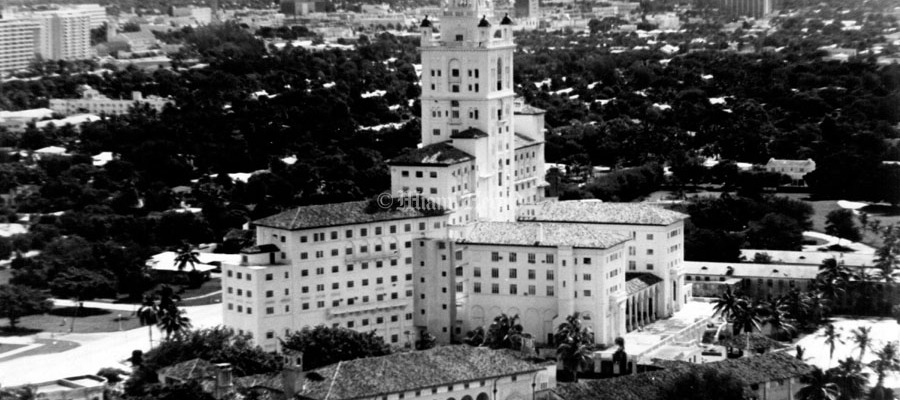Biltmore Hotel
The Biltmore Hotel has survived hurricanes, land busts, gangsters, nasty critics and even rumors of a ghost to emerge as one of South Florida’s most written-about landmarks. The Biltmore was Coral Gables developer George Merrick’s dream. He used his family’s truck garden where he grew tomatoes for the site of the new hotel. Not being superstitious, Merrick chose Friday, March 13, 1925 for ground-breaking. Biltmore was modeled after the Giralda Tower of Seville, Spain. At the time, it was called the tallest building south of Atlanta and hailed as one of the showpieces of the nation. Even the the New York Times covered its opening. But within months, the Biltmore was hit with bad luck: the 1926 hurricane and Florida’s land bust. The hotel’s protector, Merrick, went bankrupt in 1929. Under new ownership, the Biltmore managed to stay open through the Great Depression — although it was often plagued by vacancies. The Biltmore attracted the likes of Johnny Weissmuller, who swam his first world record in the hotel pool, the largest in the continental United States. Babe Ruth, Bobby Jones and the Duke and Duchess of Windsor also stayed there. Desi Arnaz, then a Miami High student, made his debut as an entertainer at the Biltmore. It also attracted gangsters. The most famous: Al Capone. In 1929, bodyguard Thomas “Fats” Walsh was shot to death on the 13th floor, which had been turned into a gambling suite for mobsters, wealthy snowbirds and bejeweled women. Walsh’s ghost allegedly prowls the Biltmore to this day.By the 1930s, critics of the Biltmore abounded. For the next four decades, the Biltmore suffered more. The government converted it into a hospital for troops wounded during World War II — and promptly covered its marble floors with linoleum and painted it a dreary white and battleship gray. At one of its lowest points, the Biltmore became a kennel for dogs used in medical experiments, and in 1968 the Veterans’ Administration abandoned the hospital it operated there. Neighborhood children in the late 1970s used to dare each other to enter the then-abandoned hulk on Halloween night. Finally, in the 1980s, aided by new federal tax breaks for the preservation of historic buildings, Coral Gables officials found investors willing to sink $47 million into the hotel. Still, there were problems with making a profit and in 1990 the hotel closed its doors again. The Hotel once again bounced back, this time for good. In 1996 it was awarded the National Historic Landmark title, the highest recognition that can be given by the federal government.
Buy any of these photos in the Herald store
Buy any of these photos in the Herald store







































































